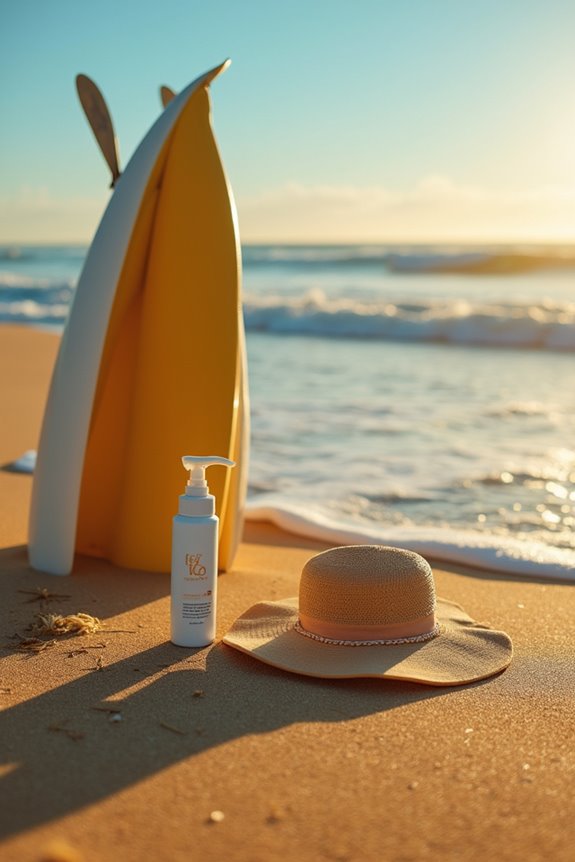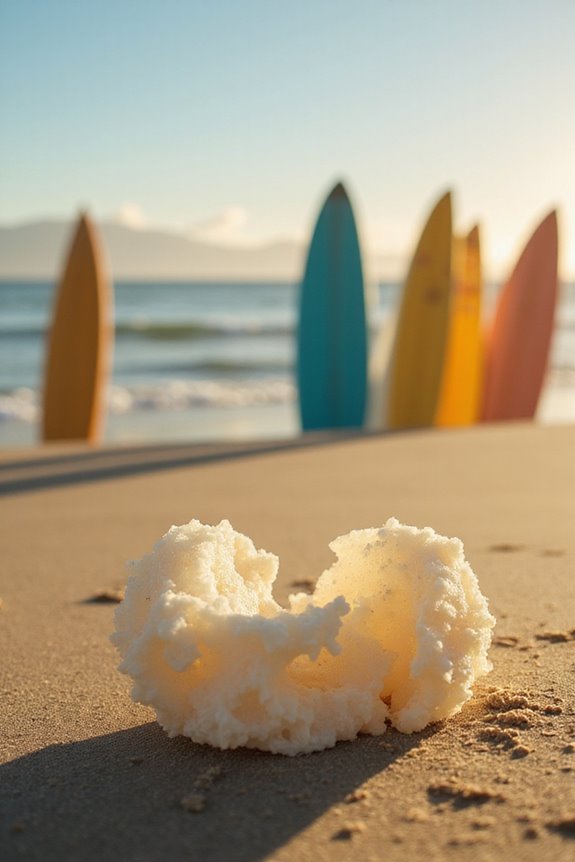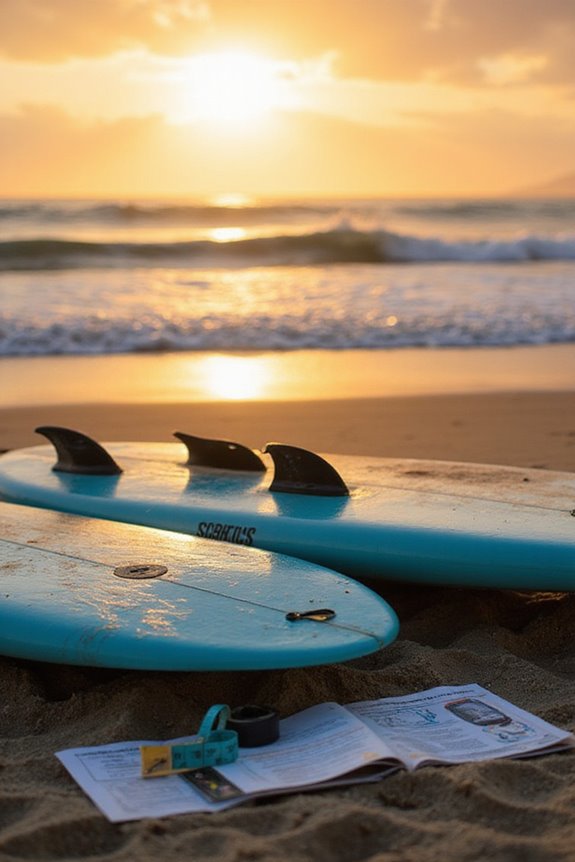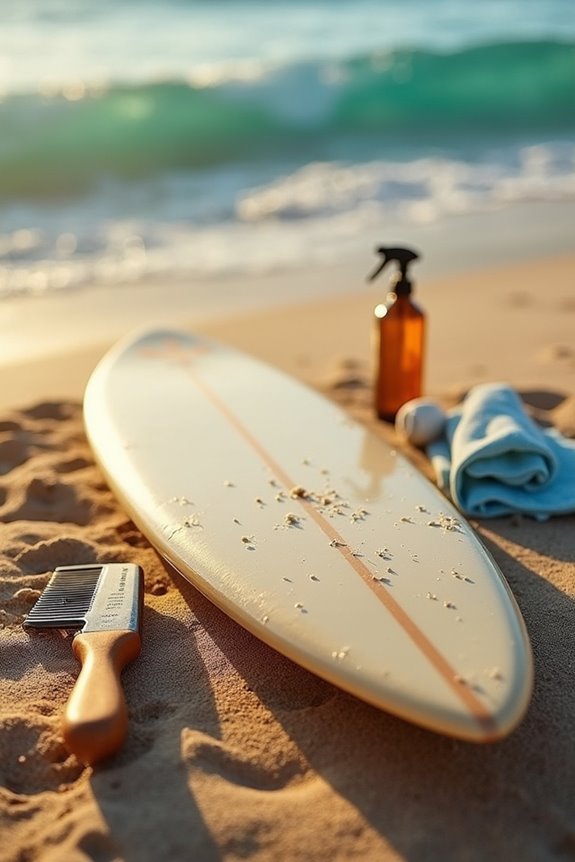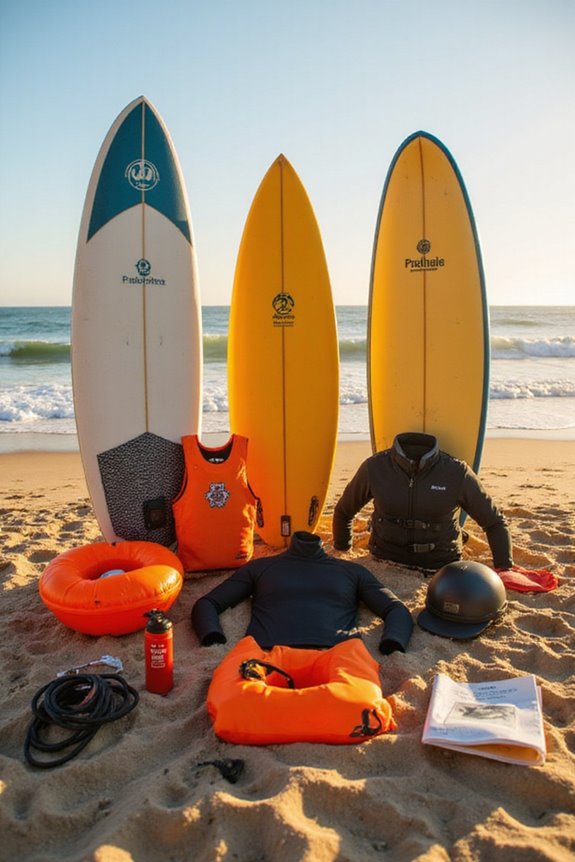To avoid sunburn while surfing, we should adopt a multi-faceted approach. First, we need to apply broad-spectrum SPF 50+ sunscreen at least 20 minutes before hitting the water and reapply every 1.5 to 2 hours. Next, we should wear UPF-rated rash guards and lightweight clothing along with a wide-brimmed hat and polarized sunglasses. Finally, limiting surf sessions during peak UV hours and seeking shade can greatly reduce our risk. There’s more to explore on effective sun safety.
Key Takeaways
- Apply broad-spectrum SPF 50+ sunscreen at least 20 minutes before surfing and reapply every 1.5 to 2 hours.
- Wear UPF-rated swimwear, like rash guards, and lightweight, long-sleeved shirts for added sun protection.
- Limit surf sessions during peak UV hours, typically between 10 a.m. and 4 p.m.
- Take breaks in shaded areas to reduce direct sun exposure while surfing.
- Use sun protective accessories like wide-brimmed hats and polarized sunglasses to shield your skin and eyes.
Understanding UV Exposure and Its Risks
As we enjoy our time surfing, it’s essential to recognize the potential dangers of UV exposure. UV radiation primarily consists of UVA and UVB rays, both capable of penetrating our skin and causing cellular damage. UVB rays mainly lead to sunburn by damaging DNA, while UVA rays contribute to skin aging and deeper tissue harm.
Surfers are particularly vulnerable, as our prolonged exposure to sunlight and reflective water can nearly double effective UV doses. Studies show that over 80% of surfers experience sunburn in a season. Additionally, chronic UV exposure can weaken our skin’s immune response, increasing the risk of developing skin cancer. Understanding these risks is vital for protecting our skin while enjoying the waves. Using broad-spectrum protection is key to minimizing the harmful effects of UV rays while surfing.
Effective Sunscreen Application and Reapplication
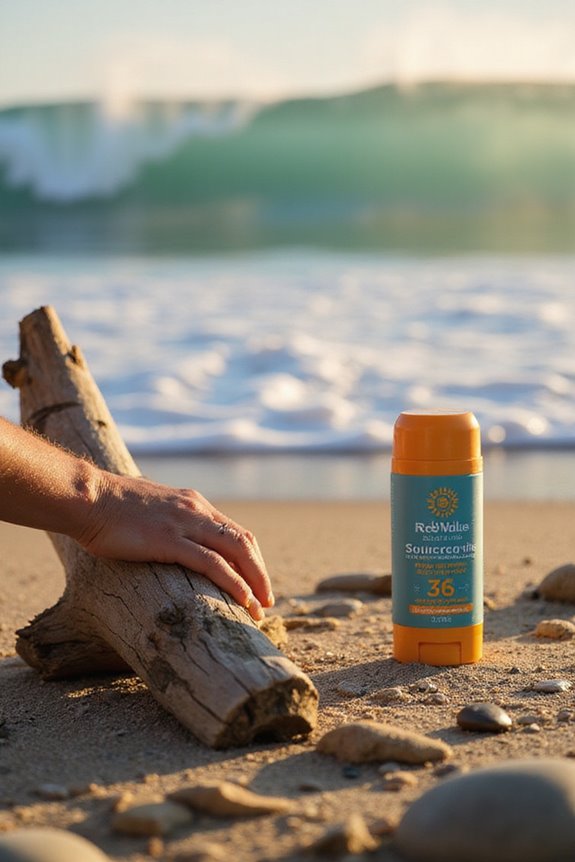
Proper sunscreen application is a key factor in reducing the risk of sunburn while surfing. We should choose a broad-spectrum SPF 50+ sunscreen formulation that is water-resistant and reef-safe. Applying it at least 20 minutes before entering the water allows it to bond effectively with our skin.
For initial application techniques, we must focus on high-exposure areas like the forehead, nose, and ears, using a thin, even layer. It’s crucial to reapply every 1.5 to 2 hours or after swimming or sweating. Convenient tools, such as wrist-mounted dispensers, can assist with quick reapplication. Even if the sunscreen claims “all-day” protection, we must maintain a routine to guarantee consistent UV defense throughout our surf session. Additionally, using mineral-based options can provide a safer choice for both your skin and the ocean environment.
The Role of Protective Clothing and Accessories
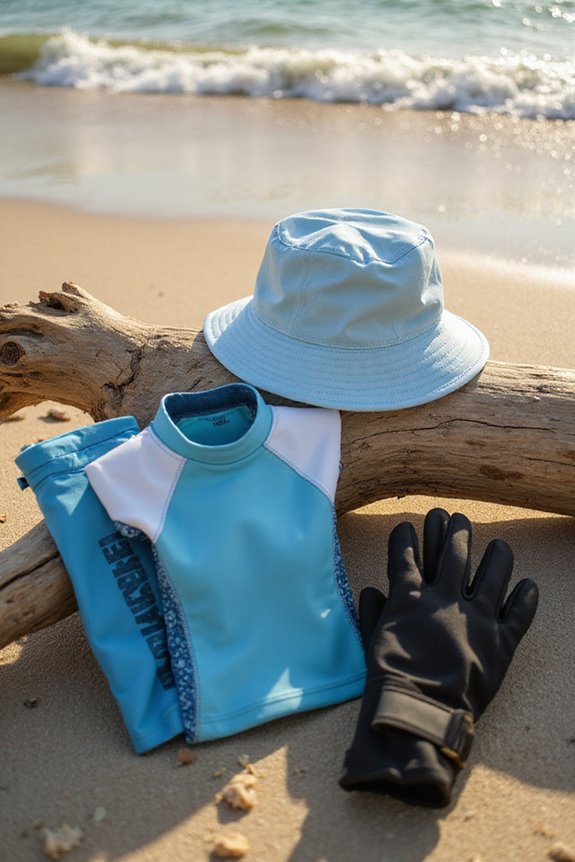
When we hit the waves, protective clothing and accessories play an essential role in safeguarding our skin from harmful UV rays. Wearing lightweight, long-sleeved shirts and long pants made from tightly woven protective fabrics offers a solid barrier against sun exposure. UPF-rated swimwear, like rash guards, provides sun protection even when wet, making them ideal for surfing. Additionally, selecting rash guards with UPF 50+ protection ensures that we block about 98% of harmful UV rays, enhancing our safety in the sun.
Additionally, sun protective accessories such as wide-brimmed hats and snug face masks shield sensitive areas, reducing the risk of sunburn. Polarized sunglasses not only block harmful UV rays but also enhance visibility, making our surfing experience safer. By combining these elements, we can effectively protect ourselves while enjoying our time in the water.
Behavioral Strategies for Sun Safety
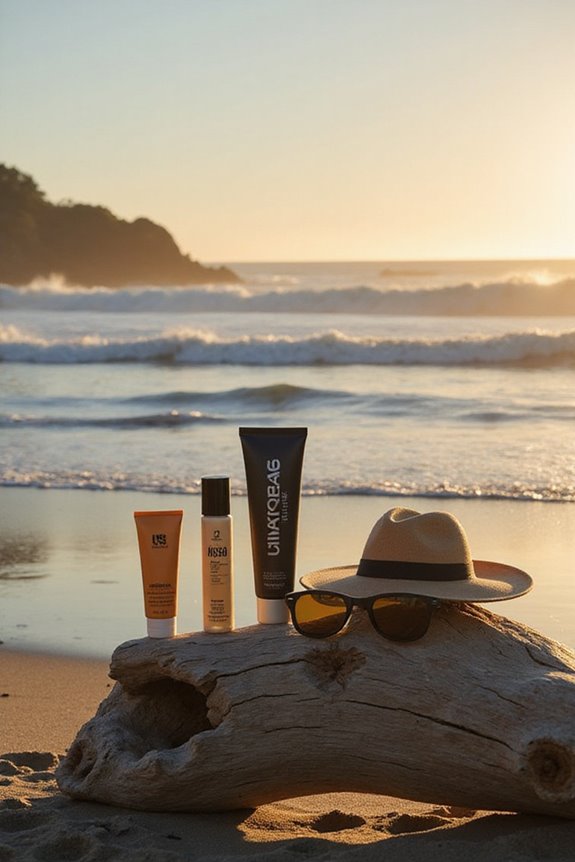
To effectively safeguard ourselves from sunburn while surfing, we need to adopt a variety of behavioral strategies that enhance our sun safety. First, let’s limit our surf sessions during peak UV hours, typically between 10 a.m. and 4 p.m. We should also take breaks in shaded areas and rotate our body positions to minimize direct sun exposure.
Additionally, we must remain vigilant with our sunscreen application. Using broad-spectrum, water-resistant sunscreen with a high SPF is essential, and we should reapply it at least every two hours. By promoting sun safety awareness among our fellow surfers, we can encourage behavioral adjustments that prioritize protection, ensuring enjoyable surf sessions without the painful aftermath of sunburn. Choosing a surf hat with UPF ratings can further enhance our sun protection while enjoying the waves.
Common Misconceptions About Sun Protection
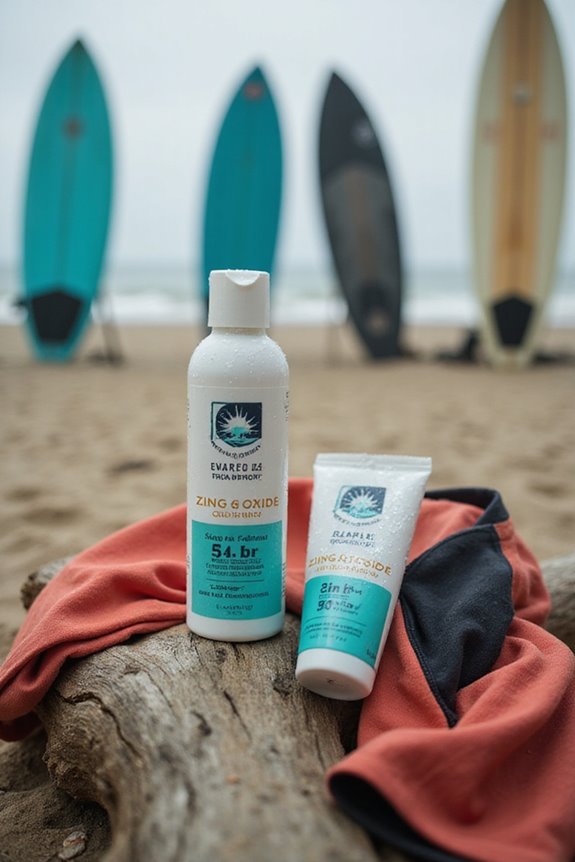
How can we navigate the many misconceptions surrounding sun protection while surfing? It’s important to recognize that higher SPF doesn’t mean markedly better protection—SPF 30 blocks about 97% of UVB rays, while SPF 50 only offers 98%. Misleading marketing can create false confidence in very high SPF products.
Relying solely on sunscreen is inadequate; we need other protective measures like shade and protective clothing. Additionally, oral supplements marketed as sunscreens are not effective at protecting the skin. The best defense combines broad-spectrum sunscreen, protective clothing, and behavioral strategies. It’s essential to choose reef-safe options to protect both your skin and the marine environment.
Let’s prioritize effective sun safety practices to minimize our risk of UV damage while enjoying our time on the waves.
Frequently Asked Questions
Can I Still Get Sunburned on Cloudy Days?
Yes, we can still get sunburned on cloudy days. Cloud cover doesn’t block UV rays, so we should always check the UV index and use sunscreen, even when it looks overcast outside.
How Can I Tell if My Sunscreen Is Expired?
To tell if our sunscreen’s expired, we should check the expiration date and look for changes in texture or smell. If the ingredients seem off, it’s time to replace it for safer sun protection.
Are There Specific Foods That Help Protect Against Sunburn?
As we gather our garden’s treasures, let’s savor antioxidant-rich foods and embrace omega-3 benefits. Together, these natural allies nurture our skin, fortifying it against sunburn while keeping our bodies vibrant and resilient under the sun’s embrace.
What Are the Signs of Sunburn I Should Look For?
When we’re looking for signs of sunburn, we should pay attention to early signs like skin redness and warmth. Severe symptoms may include blisters and peeling skin, indicating we need to take action quickly.
How Does Altitude Affect UV Exposure While Surfing?
When we’re hitting the waves at higher altitudes, we’ve got to remember that UV intensity skyrockets. The altitude impact means we need to stay extra vigilant about protection to keep our skin safe while surfing.

